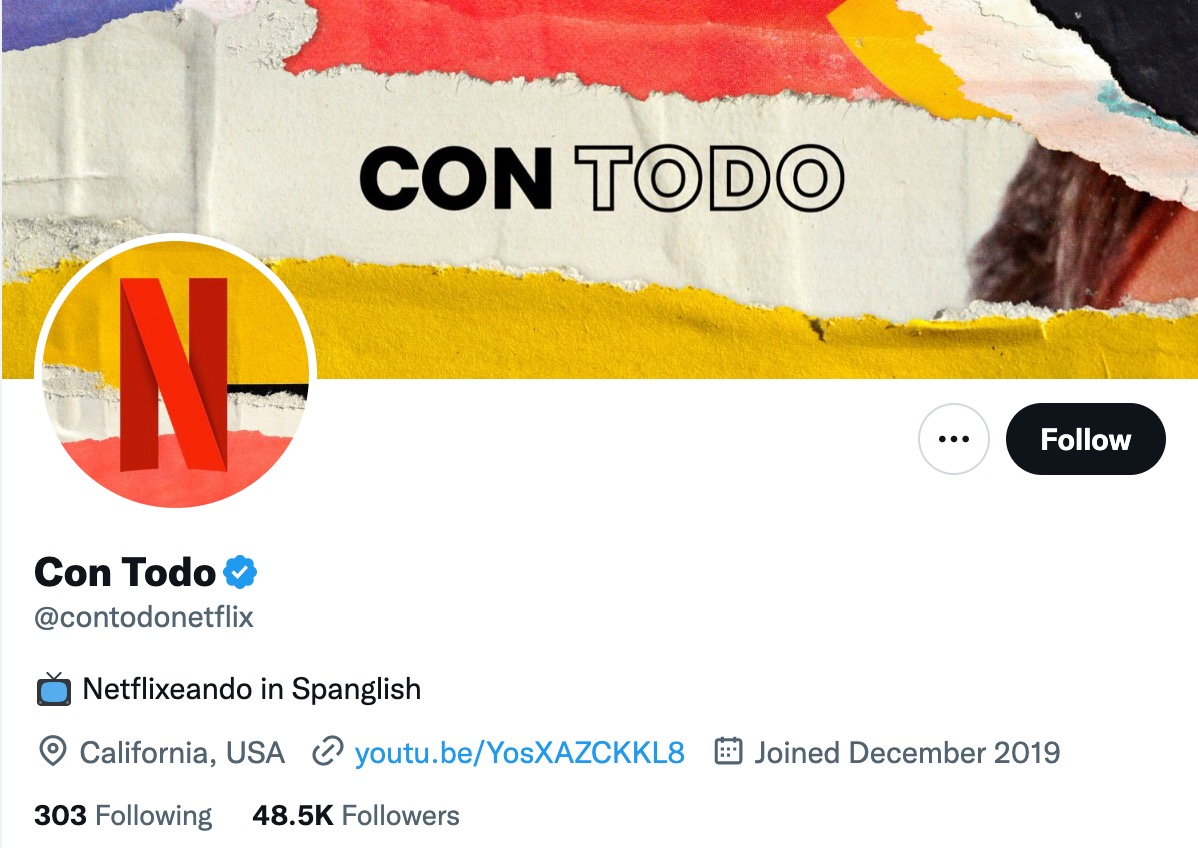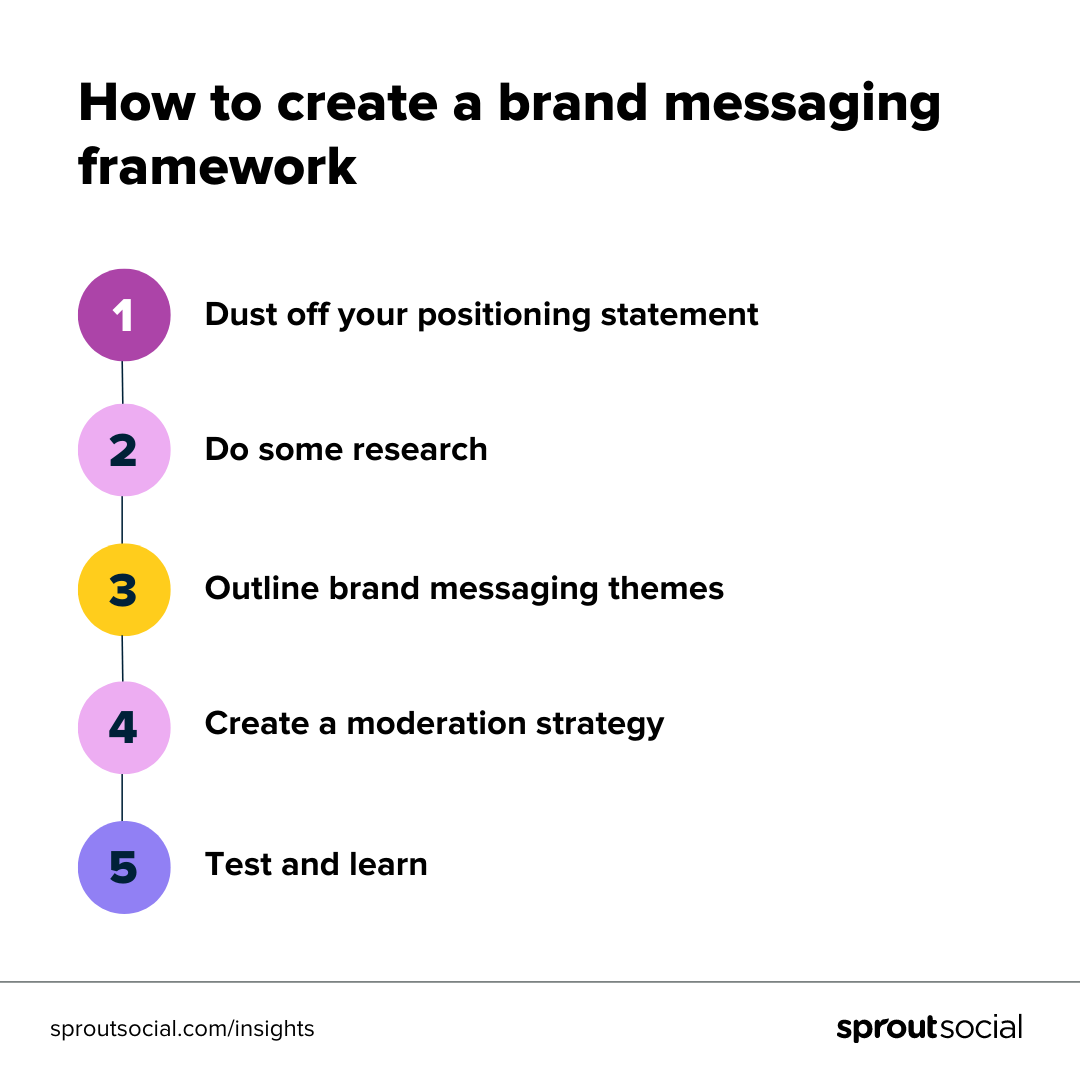Brand messaging: How to create a framework

One of the major benefits of social media is that it creates space to try new things. It’s more casual than email and less expensive than paid marketing—ideal conditions for experimenting with your brand messaging strategy.
However, before you can experiment, you need to have a proper foundation in place. Your fans should turn to your social profiles for more than just great pictures and clever copy. They should feel connected to your mission.
Creating a brand messaging framework for social can help you nail the basics so you can get more inventive with your brand reputation and enhance your brand strategy. To help you get it done, we created this guide to brand messaging basics, along with a step-by-step framework template.
What is brand messaging?
Brand messaging is how you communicate your company’s value proposition, personality and competitive differentiators across different channels.
Several factors go into a holistic brand messaging strategy. It’s not just about what you say. It also includes how you say it and who you say it to.
That’s quite a bit to account for, which is why it’s important to set and share communication guidelines that keep marketing messaging clear and on brand. The more consistent you are, the more memorable your brand becomes to your target audience.
Why brand messaging matters for your social strategy
According to a Q2 2024 Sprout Pulse Survey, more than 40% of consumers will unfollow a brand whose values don’t align with their own. People want to know that their dollar is doing more than just getting them a product or service. They want to spend with brands that stand up for what matters.
The role of brands has changed radically over the past few years. Now, when a crisis strikes, people turn to their social feeds to find a public apology or announcement. It’s not enough to sit on the sidelines of events that impact your audience or industry. You need to get in the game.
Your brand messaging strategy is the go-to starting point for figuring out how to drive more emotional connections with your target audience. It can also help inform which social issues you weigh in on and how. In today’s social media landscape, that’s worth its weight in gold.
3 examples of brand messaging frameworks in action
The best way to pick up new brand messaging tactics is to learn from the companies you love. If you’re in need of a little inspiration, check out these takeaways from three top-tier social brand messaging examples:
1. Netflix
Netflix wants to entertain the world, no matter where you’re from or what you like. It’s a noble goal but it’s also a pretty wide net to cast.
Their team overcomes this obstacle by segmenting their social presence into several profiles that speak to specific audiences. For example, check out the Twitter bio for Con Todo, their online community for Latinx fans.

In just a few words, they prove they know how to speak their audience’s language. They do the same for several other fanbases, including sci-fi fans, LGBTQ+ individuals and parents to name a few. This helps them speak authentically to their fans in a way that doesn’t alienate or overgeneralize.
Takeaway: Specificity beats sweeping statements every time. Understanding your audience (or audiences), their interests and their communication patterns will set the foundation for what your brand messaging strategy looks like in action.
2. Bumble
Bumble is a dating app where women make the first move. It’s more than just a clever reversal of traditional gender roles. It’s purposely designed to challenge romantic power dynamics in a tangible way.
Bumble’s social content makes it clear their brand mission doesn’t end at dating. Instead, they use their platform to raise awareness on issues that sit at the intersection of technology and women’s empowerment.
Congratulations to California! The signing of SB 53 in the state makes sending explicit pics without consent prohibited, with damages of up to $30,000. Click the link to learn more. https://t.co/33tUvIgERe #digitalflashingisflashing pic.twitter.com/ca6wpNRizg
— Bumble (@bumble) September 26, 2022
These efforts do more than just amplify good causes. They also ensure that fans of the brand see Bumble as more than just another dating app. Its purpose makes it stand above the rest.
Takeaway: Don’t limit your strategy to promotional content alone. Identify the causes and movements that align with your business and put the “active” in brand activism.
3. Liquid Death Mountain Water
At its best, your messaging should showcase a distinct brand personality. No one is doing personality quite like Liquid Death Mountain Water.
This canned water company has some edge. They’re on a mission to kill plastic pollution. Not “prevent” or “stop”. They literally have an evergreen hashtag campaign called #DeathToPlastic.
Talking about the environmental impacts of pollution can get pretty heavy but Liquid Death proves it doesn’t have to be. Instead, they make it funny.
Their humorous tone creates stand-out social content that doesn’t bring laughs for laughing sake alone. It also serves as a reminder to ditch single-use plastic.
Takeaway: Posts that reinforce your brand messaging strategy don’t necessarily have to take on a more serious tone. If it works with your brand voice, try experimenting with humor and see how your fans react.
How to create a brand messaging framework for social
Now that you’re all set on the basics, it’s time to create a strategy of your own. Use this section to create a brand messaging framework template to complete with the rest of your team.
Step 1: Dust off your brand positioning statement
What purpose does your company serve?
This may sound like a big, existential question but it has to be asked and regularly answered. It’s the foundation of any brand messaging strategy, whether your business is a mom-and-pop or listed on the Fortune 500.
A succinct description of your business’s purpose, its target audience and why it’s needed is known as a positioning statement. Think of it as a north star for the many departments that make up a company. The clearer it is, the easier it is to follow.
If your company has an approved positioning statement, now is the time to dig it out and look at it with fresh eyes. Identify key themes and reflect on what those might look like in action.
If you don’t have one, don’t worry. There are many places where a business might have informal language on positioning, including:
- Your website’s “About Us” page
- An approved boilerplate
- Your company values
These sources can help you create a makeshift position statement. Create one, share it with your leadership team and politely suggest they prioritize developing an approved version in the near future.
Step 2: Do some research
Now that you have your north star, it’s time to figure out where your business currently stands in the market—and in the minds of your target audience. Gather insights on your online reputation, audience interests and larger industry conversations to chart a path toward brand messaging success.
There are a few ways to approach this research but since this is a social-specific strategy, it only makes sense to power it with social insights. If you’re using Sprout, here are the top three reports you should use to inform your findings:
- Use the Post Performance Report to find out what content has been resonating most with your audience. Are there specific content formats or themes that drive engagement?
- Create an Industry Insights Listening Topic to synthesize larger conversations that are happening in your industry. What are people talking about? How do they feel about the topic?

- Create a Competitive Analysis Listening Topic to compare your brand’s share of voice to key competitors. Where do you rank? What are your competitors doing better? What can you learn from their strategy?
Record your findings and keep them close. You’re going to need them for the next step.
Step 3: Outline brand messaging themes
As you look at all the research you’ve pulled together so far, you’ll probably notice that there are multiple aspects of your brand message you can focus on. Choosing three to five core brand messaging themes will help plan and track your efforts in a more targeted manner.
What does this look like in action? Let’s take a look at Bombas, for example.

Their Instagram content is more than just pretty product shots. Instead, they diversify their content by incorporating several aspects of their mission, from their community-focused mission to their commitment to quality.
Identifying a few themes to stick to will help you mimic their approach so you can create a feed that reflects and reinforces the most important aspects of your brand. Plus, it’ll make coming up with new social media ideas way easier.
Step 4: Create a moderation strategy
Remaining proactive and agile in a 24-hour news cycle takes careful planning. After all, you never know when a world event or cultural moment is about to strike.
Creating a social media moderation strategy can help you protect the brand image you work hard to maintain and improve. This is not the same as your crisis management plan—that’s for when an issue is active and in motion. Instead, your moderation strategy should be geared toward assessing and acting on any potential threats to your brand on social.
While the bulk of your moderation strategy will focus on assessing developing issues, there are some preemptive discussions that need to happen to inform your approach. Go over the following questions with your team and record the agreed-upon responses:
- When do we as a brand speak out on tough issues? Which individuals/teams shape our response?
- When should we pause content publishing? Who is involved in that decision?
- How do we respond to public criticism? What does our brand sound like in those situations?
- How do we approach issues that cannot be immediately resolved?
Step 5: Test and learn
As your brand messaging strategy comes to fruition, eventually you’ll be able to benchmark your progress against your brand’s historical performance.
Post content aligning to your new themes consistently for four to six weeks. You’ll want to have enough posts under each theme to gather a meaningful amount of data. Once that time period passes, it’s time to dig into performance.
Which themes house the best-performing content? Of that content, are there any formats or messaging that’s resonating more than others? Nail down what’s working and apply those learning to your other content themes.
Craft brand messaging that resonates
Creating impactful brand messaging is both an art and a science. Use data to supplement your natural creativity and you’ll create a social presence that builds and strengthens connections with your core audience.
Brand messaging is a key component in driving brand awareness. It is critical for connecting with your target audience and creating more meaningful connections between your brand and its customers.




Share